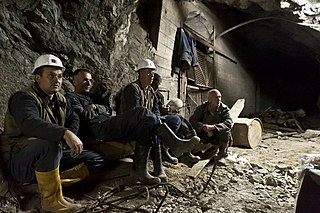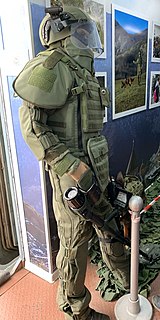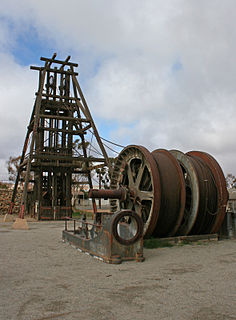Related Research Articles

Mining is the extraction of valuable minerals or other geological materials from the Earth, usually from an ore body, lode, vein, seam, reef, or placer deposit. Exploitation of these deposits for raw material is based on the economic viability of investing in the equipment, labor, and energy required to extract, refine and transport the materials found at the mine to manufacturers who can use the material.

Engineers, as practitioners of engineering, are professionals who invent, design, analyze, build and test machines, complex systems, structures, gadgets and materials to fulfill functional objectives and requirements while considering the limitations imposed by practicality, regulation, safety and cost. The word engineer is derived from the Latin words ingeniare and ingenium ("cleverness"). The foundational qualifications of an engineer typically include a four-year bachelor's degree in an engineering discipline, or in some jurisdictions, a master's degree in an engineering discipline plus four to six years of peer-reviewed professional practice and passage of engineering board examinations.

Underground hard-rock mining refers to various underground mining techniques used to excavate "hard" minerals, usually those containing metals, such as ore containing gold, silver, iron, copper, zinc, nickel, tin, and lead. It also involves the same techniques used to excavate ores of gems, such as diamonds and rubies. Soft-rock mining refers to the excavation of softer minerals, such as salt, coal, and oil sands.

A miner is a person who extracts ore, coal, chalk, clay, or other minerals from the earth through mining. There are two senses in which the term is used. In its narrowest sense, a miner is someone who works at the rock face; cutting, blasting, or otherwise working and removing the rock. In a broader sense, a "miner" is anyone working within a mine, not just a worker at the rock face.

A sapper, also called pioneer or combat engineer, is a combatant or soldier who performs a variety of military engineering duties, such as breaching fortifications, demolitions, bridge-building, laying or clearing minefields, preparing field defenses, and road and airfield construction and repair. They are also trained and equipped to serve as provisional infantry, fighting as such as a secondary mission. A sapper's duties facilitate and support movement, defense, and survival of allied forces and impede those of enemies. The term "sapper" is used in the British Army and Commonwealth nations and the U.S. military. The word "sapper" comes from the French word sapeur, itself being derived from the verb saper.

The Corps of Royal Engineers, usually called the Royal Engineers (RE), and commonly known as the Sappers, is a corps of the British Army. It provides military engineering and other technical support to the British Armed Forces and is headed by the Chief Royal Engineer. The Regimental Headquarters and the Royal School of Military Engineering are in Chatham in Kent, England. The corps is divided into several regiments, barracked at various places in the United Kingdom and around the world.

A combat engineer is a type of soldier who performs military engineering tasks in support of land forces combat operations. Combat engineers perform a variety of military engineering, tunnel and mine warfare tasks as well as construction and demolition duties in and out of combat zones.
Regulation and licensure in engineering is established by various jurisdictions of the world to encourage life, public welfare, safety, well-being, then environment and other interests of the general public and to define the licensure process through which an engineer becomes licensed to practice engineering and to provide engineering professional services and engineered product to the public.

The Colorado School of Mines is a public research university in Golden, Colorado, founded in 1874. The school offers both undergraduate and graduate degrees in engineering, science, and mathematics, with a focus on energy and the environment. While Mines does offer minor degrees in the humanities, arts, and social sciences, it only offers major degrees in STEM fields, with the exception of economics. In the Fall 2019 semester, the school had 6,607 students enrolled, with 5,155 in an undergraduate program and 1,452 in a graduate program. The school has been co-educational since its founding, however, enrollment remains predominantly male. In every QS World University Ranking from 2016 to 2020, the university was ranked as the top institution in the world for mineral and mining engineering. It is classified among "R1: Doctoral Universities – Very high research activity".

Christian Brothers University is a four-year private university in Memphis, Tennessee founded in 1871 by the De La Salle Christian Brothers, a Catholic teaching order. CBU fosters academic excellence in a range of programs to prepare students from all faiths and backgrounds for careers and lives informed by the Lasallian values of faith, service, and community.

Mining in the engineering discipline is the extraction of minerals from underneath, open pit, above or on the ground. Mining engineering is associated with many other disciplines, such as mineral processing, exploration, excavation, geology, and metallurgy, geotechnical engineering and surveying. A mining engineer may manage any phase of mining operations, from exploration and discovery of the mineral resources, through feasibility study, mine design, development of plans, production and operations to mine closure.

A hoist is a device used for lifting or lowering a load by means of a drum or lift-wheel around which rope or chain wraps. It may be manually operated, electrically or pneumatically driven and may use chain, fiber or wire rope as its lifting medium. The most familiar form is an elevator, the car of which is raised and lowered by a hoist mechanism. Most hoists couple to their loads using a lifting hook. Today, there are a few governing bodies for the North American overhead hoist industry which include the Hoist Manufactures Institute, ASME, and the Occupational Safety and Health Administration. HMI is a product counsel of the Material Handling Industry of America consisting of hoist manufacturers promoting safe use of their products.

A headframe is the structural frame above an underground mine shaft so as to enable the hoisting of machinery, personnel, or materials.
A mining feasibility study is an evaluation of a proposed mining project to determine whether the mineral resource can be mined economically. There are three types of feasibility study used in mining, order of magnitude, preliminary feasibility and detailed feasibility.

Underground mine ventilation provides a flow of air to the underground workings of a mine of sufficient volume to dilute and remove dust and noxious gases (typically NOx, SO2, methane, CO2 and CO) and to regulate temperature. The source of these gases are equipment that runs on diesel engines, blasting with explosives, and the orebody itself. The largest component of the operating cost for mine ventilation is electricity to power the ventilation fans, which may account for one third of a typical underground mine's entire electrical power cost.
The Hard Rock Miner's Handbook is a reference book that deals with the underground hard-rock mining industry. It was written by engineer Jack de la Vergne as a non-profit publication. The first edition was published in 2000 by McIntosh Engineering, a mining engineering consulting company. It is currently in its third printing, is used by thousands of people in the mining industry, including students, professors, miners, engineers and mining executives as a source of practical mining information, as well as "Rules of Thumb" and "Tricks of the trade" are used widely in the mining industry. Copies of the handbook have been distributed to more than 113 countries around the world.

In underground mining a hoist or winder is used to raise and lower conveyances within the mine shaft. Modern hoists are normally powered using electric motors, historically with direct current drives utilizing Ward Leonard control machines and later solid-state converters (thyristors), however modern large hoists use alternating current drives that are variable frequency controlled. There are three principal types of hoists used in mining applications:

Missouri University of Science and Technology, or Missouri S&T, is a public research university in Rolla, Missouri. It is a member institution of the University of Missouri System. Most of its 7,645 students study engineering, business, sciences, and mathematics. Known primarily for its engineering school, Missouri S&T offers degree programs in business and management systems, information science and technology, sciences, social sciences, humanities, and arts. It is classified among "R2: Doctoral Universities – High research activity".

The 2010 Copiapó mining accident, also known then as the "Chilean mining accident", began on 5 August 2010, with a cave-in at the San José copper–gold mine, located in the Atacama Desert 45 kilometers (28 mi) north of the regional capital of Copiapó, in northern Chile. Thirty-three men, trapped 700 meters (2,300 ft) underground and 5 kilometers (3 mi) from the mine's entrance via spiraling underground ramps, were rescued after 69 days.

LHD loaders are similar to conventional front end loaders but developed for the toughest of hard rock mining applications, keeping overall production economy, safety, and reliability in consideration. They are extremely rugged, highly maneuverable, and exceptionally productive. More than 75% of the world's underground metal mines use LHD for handling the muck of their excavations.
References
- 1 2 Ross, Ian (13 February 2006). "Living Legend Lends Engineering Expertise". Red Orbit.
- ↑ "John (Jack) Nicholas de la Vergne, P.Eng". Professional Engineers Ontario.
- ↑ "2005 Honours bestowed upon trio". Archived from the original on 2011-07-08. Retrieved 2008-10-23.
- ↑ "John (Jack) de la Vergne". Archived from the original on 2010-11-27. Retrieved 2008-10-23.